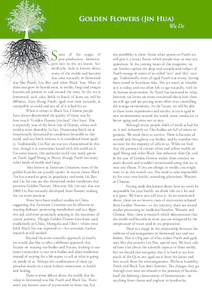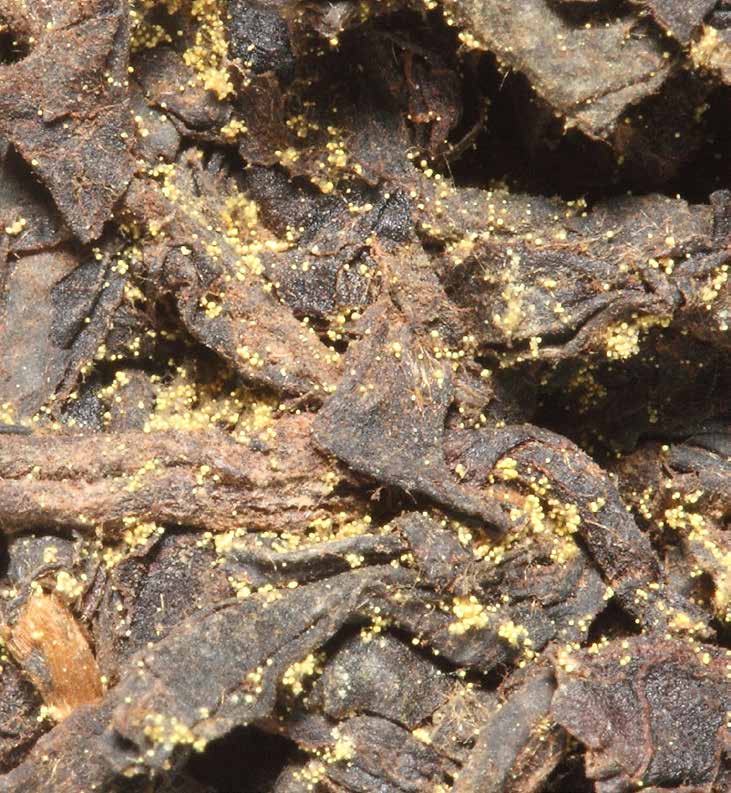
 |
|
Some of the magic of post-production fermentation isn't in the tea leaves. Scientifically, little is known about many of the molds and bacteria that arise naturally in fermented teas like Puerh, Liu Bao and other Black Teas. Most of these teas grow in humid areas, so molds, fungi and unique bacteria are present in and around the trees. As the tea is fermented, each cake, brick or batch of loose tea will be different. Even Sheng Puerh, aged over time naturally, is susceptible to mold and not all of it is bad for us.
When it comes to Black Tea, Chinese people have always determined the quality of many teas by how much "Golden Flowers (jin hua)" they have. This is especially true of the brick teas of Hunan, where such mold is most desirable. In fact, Hunnanese brick tea is intentionally fermented in conditions favorable to this mold, and any brick without it is considered lower quality. Traditionally, Liu Bao tea was not characterized in this way, though it is sometimes found with this mold on it. For some reason, this particular mold very rarely grows on Puerh (aged Sheng or Shou), though Puerh has many other kinds of molds and fungi.

Also known as Eurotium Cristatum, most of the golden bunches are actually spores. In recent times, Black Tea has started to grow in popularity and some Liu Bao and Liu An teas are also fermented under conditions that promote Golden Flowers. However, Mr. Lin says that our 2000 Liu Bao naturally developed these flowers, making the tea more precious.
There have been medical studies in China suggesting that Eurotium Cristatum can be effective in treating diabetes, promoting metabolism and as a digestive aid, and even potentially assisting in the treatment of cancer patients. Though Golden Flowers have been used medicinally in China, Mongolia and Tibet - where most brick Black Tea was exported to - for centuries, further research is still needed.
Beyond the more scientific approach to health, we would also like to offer a different approach that focuses on trusting our bodies and Nature, looking to our inner connection to our own bodies and plant medicines instead of waiting for a lab report to tell us what is going on inside of us. Perhaps the combination of these approaches results in a more holistic orientation to health and healing.
There is some debate about the molds that develop in fermented teas like Puerh and Black Tea. There aren't any known cases of mycotoxins in these teas, but the possibility is there. Some white spores on Puerh tea will give it a musty flavor, which people may or may not appreciate. In the coming issues of this magazine, we can further explore the deep and complicated subject of Puerh storage in terms of so-called "wet" and "dry" storage. Traditionally, most all aged Puerh was musty, having been stored in Southeast Asia. The tea wasn't as valuable as it is today, and was often left to age naturally, with little human intervention. As Puerh has increased in value, however, tea lovers are more concerned about how their tea will age and are putting more effort into controlling the storage environment. In the future, we will be able to share more experiments and results, as tea is aged in new environments around the world, some conducive to better aging and some not so nice.
Although many people think of mold as bad for us, it isn't inherently so. Our bodies are full of micro-organisms. We need them to survive. There is bacteria all around and throughout our bodies, and by number they account for the majority of cells in us. While we find that the presence of certain white and yellow molds on aged Sheng and other Black Teas enhances their Qi, and in the case of Golden Flowers makes them sweeter, we aren't doctors and wouldn't recommend using this tea to treat any illness. If you are allergic to molds, you might want to sit this month out. You need to take responsibility for your own health, consulting physicians, Western or Chinese.
Putting aside disclaimers about how we won't be responsible for your health, we drink this tea a lot and it is great. We know you will love it. As we mentioned above, there are no known cases of mycotoxins released from Golden Flowers - to the contrary, there are several studies promoting its medicinal benefits, Western and Chinese. Also, there is research which demonstrates that the molds and bacteria in most teas are mitigated by the temperature of water used in tea preparation.
There is a magic in the relationship between the millions of microorganisms in fermented teas and our bodies. This is a big part of what makes Puerh and aged teas, like this month's Liu Bao, special teas. We have talked here a lot about the scientific aspects of these molds, but we should also recognize that it is hard to say how much of the Qi in any aged tea is from the leaves and how much from the microorganisms. Without humidity, Puerh and Black Teas don't ferment. The changes they go through over time are related to the presence of bacteria, itself the defining characteristic of fermentation - in anything from cheese and yoghurt to kombucha.
The mold adds a deepening to the Qi, making it more Yin, while sweetening the tea, bringing a longer-lasting huigan. Microorganisms - molds and bacteria - are part of what makes tea and the world alive. See if you can feel them in your brew, and what differences they bring to this tea experience!
We have other Liu Bao teas from all different ages, some of which are fifty or sixty years old, some from the 1980's, 90's and early 00's. Very few of them have Golden Flowers like this tea, but we compared a 2000 Liu Bao we previously owned with the one donated by Mr. Lin and the one with the Golden Flowers tasted better, was deeper and resulted in a more rewarding brew. In the end, you will have to be the judge, enjoying this unique chance to have an aged Black Tea with Golden Flowers!
